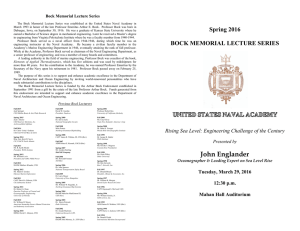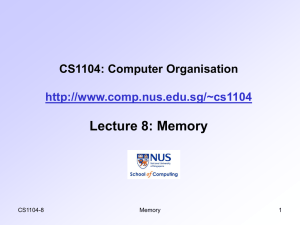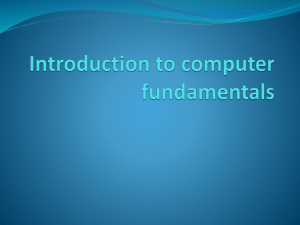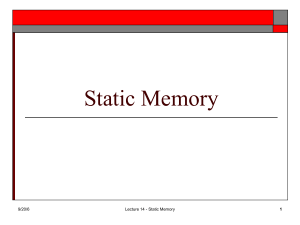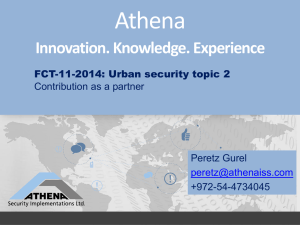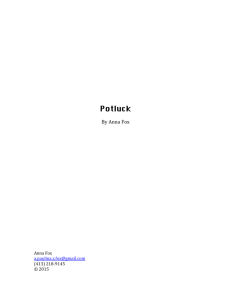Artificial Intelligence: Can Machines Think?
advertisement
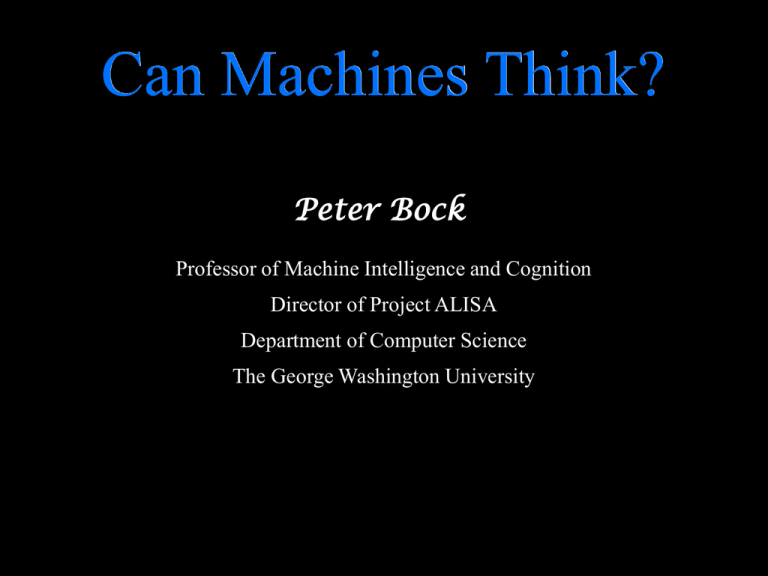
Can Machines Think? Peter Bock Professor of Machine Intelligence and Cognition Director of Project ALISA Department of Computer Science The George Washington University Background Issues Assumption: ... the question of whether Machines Can Think ... is about as relevant as the question of whether Submarines Can Swim. [Dijkstra 1984] Axiom: The whole is greater than the sum of its parts. [??????????] Definition: A part of an entity consists exclusively of matter and/or energy. [Bock 2005] Axiom: The whole is exactly equal to the sum of its parts; if it seems otherwise, at least one of its parts has been overlooked. Definition: A set may be arbitrarily large and complex. [Bock 2005] [Cantor 1874] 1 Background Issues Assumption: ... the question of whether Machines Can Think ... is about as relevant as the question of whether Submarines Can Swim. Axiom: The whole is greater than the sum of its parts. [Dijkstra 1984] [??????????] Definition: A part of an entity consists exclusively of matter and/or energy. [Bock 2002] Axiom: The whole is exactly equal to the sum of its parts; if it seems otherwise, at least one of its parts has been overlooked. Definition: A set may be arbitrarily large and complex. [Bock 2002] [Cantor 1874] Fundamental Propositions Definition: Intelligence is the ability of an entity to synthesize responses that are significantly correlated with its stimuli. [Bock 1993] Postulate: Intelligence capacity is a measure of the amount of information that can be stored in the memory of an entity. [Bock 1993] Definition: The standard unit of information is the bit, which is the base-2 logarithm of the number of unique states an entity can be in. [Shannon & Weaver, 1949] 2 Examples of Intelligence Capacity Entity Intelligence Capacity (bits) toggle switch 100 = 1 worm 104 = 10,000 sea slug 107 = 10,000,000 tiny lizard 108 = 100,000,000 = 10 MB desktop computer 1010 = 10,000,000,000 = 1 GB DNA molecule 1010 = 10,000,000,000 = 1 GB frog 1011 = 100,000,000,000 = 10 GB mainframe computer 1012 = 1,000,000,000,000 = 100 GB dog 1014 = 100,000,000,000,000 = 10,000 GB = 10 TB human being 1015 = 1,000,000,000,000,000 = 100 TB human species 1025 = 10,000,000,000,000,000,000,000,000 = 1 YB universe 1084 = 1,000,000,000,000,000,000,000, 000,000,000,000,000,000,000, 000,000,000,000,000,000,000, 000,000,000,000,000,000,000 (number of baryons) 3 Growth of Computer Memory Capacity RAM capacity (bytes) generation period technology PC % human 1 1952 - 1958 vacuum tube 2 1958 - 1964 transistor 1 KB 3 1964 - 1970 SSI 10 KB 4 1970 - 1976 MSI 100 KB 5 1976 - 1982 LSI 1 MB 100 KB 0.000001 6 1982 - 1988 VLSI 10 MB 1 MB 0.00001 7 1988 - 1994 CISC 100 MB 10 MB 0.0001 8 1994 - 2000 RISC 1 GB 100 MB 0.001 9 2000 - 2006 NOW MP RISC 10 GB 1 GB mainframe 0.1 KB 0.01 Frog 4 Growth of Computer Memory Capacity Generation 1 2 3 4 5 6 7 8 9 1 Petabyte human brain 1 Terabyte Memory Capacity 1 Gigabyte 1 Megabyte PC RAM 1 Kilobyte Mainframe RAM 1952 1958 NOW 1964 1970 1976 1982 1988 1994 2000 2006 Time Period 5 Growth of Computer Memory Capacity Generation 1 2 3 4 5 6 7 8 9 1 Petabyte human brain 1 Terabyte Memory Capacity 1 Gigabyte 1 Megabyte my PC disk capacities my PC RAM capacities PC RAM 1 Kilobyte Mainframe RAM 1952 1958 NOW 1964 1970 1976 1982 1988 1994 2000 2006 Time Period 6 Growth of Computer Memory Capacity Generation 1 2 3 4 5 6 7 8 9 10 11 12 13 14 1 Petabyte human brain 1 Terabyte Memory Capacity technology change 1 Gigabyte 1 Megabyte 1 Kilobyte PC RAM Mainframe RAM 1952 1958 1964 1970 NOW 1976 1982 1988 1994 2000 2006 2012 2018 2024 2030 2036 Time Period 7 Knowledge Acquisition Definition: Knowledge is the instantiation of intelligence. Definition: Cognition (Thinking) is the mental process of acquiring, representing, processing, and applying knowledge. 8 Knowledge Acquisition Definition: Knowledge is the instantiation of intelligence. Definition: Cognition (Thinking) is the mental process of acquiring, representing, processing, and applying knowledge. Programming 10% capacity of the brain 1 line of code (rule) software production rate software production time ≈ ≈ ≈ ≈ ≈ 1014 bits 1000 bits ≈ 100 billion rules 10 lines of code per person-hour 1010 person-hours 10,000,000 person-years !!! IMPOSSIBLE !!! Fact: This approach for achieving robust AI was abandoned in the mid-1980’s. NONETHELESS... Fact: CYC: rule-based system funded by DARPA and directed by Douglas Lenat • under construction for more than 20 years at MCC in Texas • objective is to include 1 billion “common sense” rules • no significant successes and many, many failures 9 Knowledge Acquisition Direct Transfer 10% capacity of the brain ≈ 1014 bits data transfer rate ≈ 108 bits per second data transfer time ≈ 106 seconds ≈ 12 days GREAT !!! HOW ??? 10 Knowledge Acquisition Learning Definition: Learning is the dynamic acquisition and application of knowledge based on unsupervised and supervised training. 10% capacity of the brain ≈ 1014 bits average rate of sensory input ≈ 500,000 bits per second knowledge acquisition time ≈ 200,000,000 seconds ≈ 3500 days (16 hours per day) ≈ 10 years THAT’S BETTER !!! Collective Learning Systems (CLS) [Bock 1976] Definition: Project ALISA is an adaptive non-parametric parallel-processing statistical knowledge acquisition and classification system based on CLS theory. [Bock, et al. 1992] Practical applications are illustrated on my website. 11 Training Style Derived Art Edvard Munch (10 images) Source Image mimicry = 25% brush size = thick influence = high photograph Courtesy of Ben Rubinger 12 Training Style Derived Art Monet (39 images) Source Image photograph Courtesy of Ben Rubinger mimicry = 28% brush size = large influence = high 13 Training Style Derived Art Sam Brown (171 images) Source Image mimicry = 28% brush size = medium influence = medium photograph Courtesy of Ben Rubinger 14 Training Style Derived Art brick walls (6 images) Source Image mimicry = 24% brush size = medium influence = high photograph Courtesy of Ben Rubinger 15 le début


